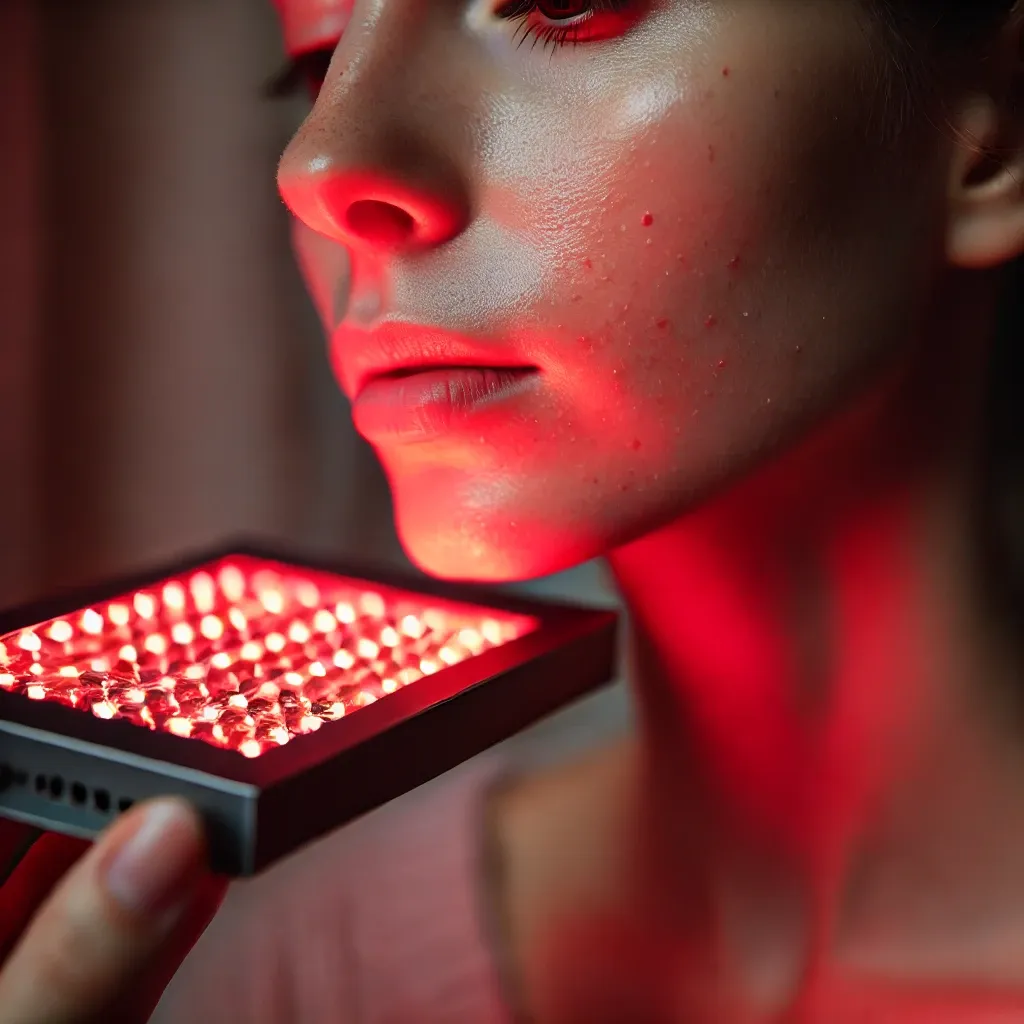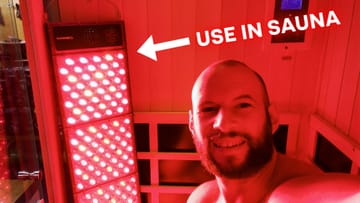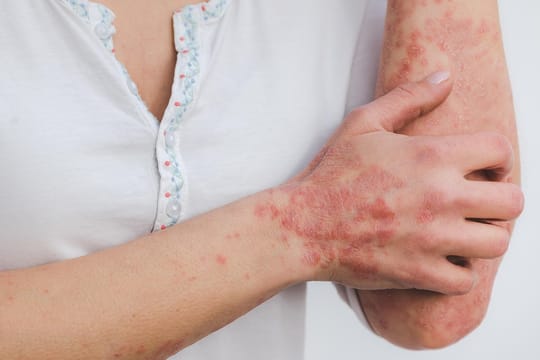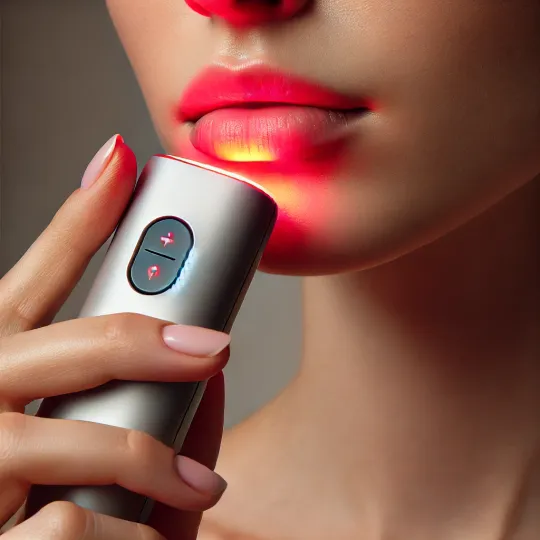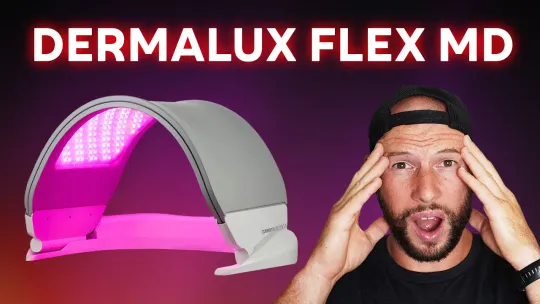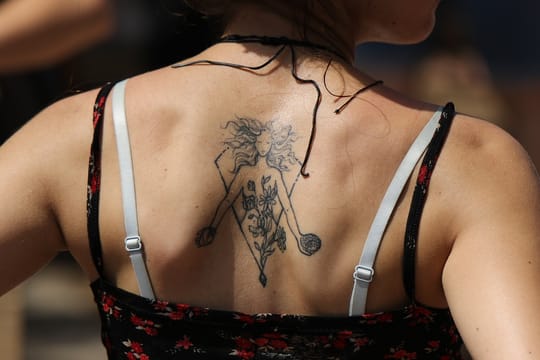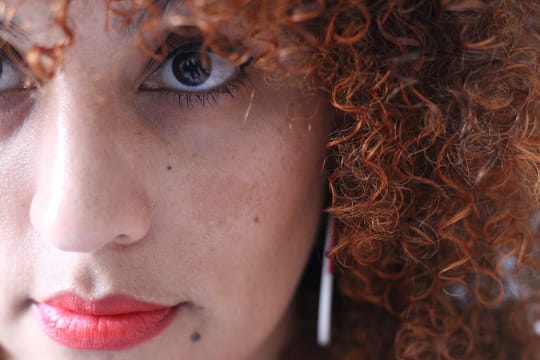Eczema, which mostly consists of "atopic dermatitis" in dermatology, is quite an issue for many people. But today, I've got good news for you: red light therapy for eczema works, and I'll explain how it works to you and some treatment protocols you may want to consider!
You may also want to consider some other skin and beauty red light therapy articles of mine and others of our team, such as:
- Red Light Therapy For Skin: Beauty Benefits, Potential Complications, And More - a great introduction to the general red light therapy for skin health benefits.
- What Light Therapy Is Best for Rosacea? - how to use red light therapy for skin redness!
- Does Red Light Therapy Help Scars? The Science - the title says it all!
- Beauty Angel Total Body Enhancement Review: Red Light Therapy At Crunch Fitness & Planet Fitness - a device often used to treat eczema but that may not be optimal!
- LED Mask Vs Red Light Therapy Panel: Which Is Best? - if you're not sure to get a mask for your face or a red light therapy panel
But let's now consider the question "is red light therapy good for eczema"? If you're short on time, only read the summary below:
In this article I mainly focus on the main form of eczema, atopic dermatitis. Atopic dermatitis is a chronic inflammatory skin conditions characterized by redness, itching, dryness, and an increased risk of infection. Children are affected more often (20%) than adults (5%). Atopic dermatitis is tied to parts of the immune system that's overactive, and often paired with other conditions such as asthma and allergic rhinitis. Genetics play a role in the condition as well.
Normally, atopic dermatitis is treated by prescription medication and substances applied to the skin. However, for most people, that medication doesn't control the condition's symptoms sufficiently. So you may still have lots of itching at night, for instance, or redness and scaling skin, despite treatment for eczema.
And that's where red light therapy comes in. Here, red light at 630 - 660 nm and near-infrared light in the 830 - 850 nm range show positive effects on the overactive immune system I've discussed. The gold standard, however, for eczema still seems to be ultraviolet light B exposure (the UV light that builds vitamin D in your skin), but I only recommend using that under medical supervision. A combination of red, near-infrared, and ultraviolet B light is likely to give the best eczema support here.
Red light therapy helps with inflammation and immune modulation and aids your skin barrier function. Lower doses of up to 8-10 J/cm2 are likely best here with the red and near-infrared light. At the end of this article, I've included some device suggestions as well - if you've got local eczema, you can do great with an inexpensive handheld or tabletop panel already!
If you need an introduction to what these terms mean, check the following resources:
- What Is Red Light Therapy?
- Red Light Therapy Explained: Basic Terms Guide
- Start Here - Light Therapy 101 & Buyers Guide
- Red Light Therapy Dosing Chart: The Raw Data From Hundreds Of Studies
- Red Light Therapy Dosing: Why It's Complicated!
- Red Light Therapy Wavelengths Benefits: The Ultimate Guide
- How Often Should You Use Red Light Therapy Explained
These resources should give you a basic understanding of how red light therapy works, and the discussions around it!
The picture at the top of this article is AI-generated though!
Understanding Eczema
Many great scientific reviews on eczema have been published in the last few years. Atopic dermatitis is the most common form of eczema; I'll focus mainly on it in this article.
So let's consider the most common form of eczema, or "atopic dermatitis", or "atopic eczema", as it's known in the scientific literature. Many good reviews have come out on the eczema topic (1; 2; 3; 4; 5; 6; 7; 8; 9; 10).
But what is the main form of eczema called "atopic dermatitis"? Atopic dermatitis, simply put, is a chronic inflammatory skin condition. The inflammation, as almost always, is paired with redness. The skin is also itchy, dry and scaly in many cases, with eczema. And, due to the poorer skin barrier function, you may be more prone to infections at the places where the atopic dermatitis is present.
Atopic dermatitis most often originates in childhood and continues into adulthood. Up to 20% of children are affected by eczema–that percentage decreases to around 5% into adulthood. These percentages have increased two to threefold in the last few decades in developed nations!
The leading cause of atopic dermatitis is an overactive immune system. Atopic dermatitis is related to other immune conditions, such as allergic rhinitis and asthma (11; 12; 13; 14). So allergies and immune dysfunction are intertwined in this case! The same is true for food allergies, which are also linked to atopic dermatitis.
With atopic dermatitis, you have a 70% chance of developing asthma or allergic rhinitis! The food allergy risk is 30%.
The causes of atopic dermatitis are nevertheless not fully understood. The causes probably consist of a combination of genetics, immune dysfunction, and environmental factors (such as what the immune system is exposed to in the early years!)
The filaggrin gene here is one main factor. That gene can make your skin less moist and more prone to be affected by irritants and allergens. And once compromised, the skin will start having more issues! If one of the parents has atopic dermatitis, there's about a 40% chance their kid will also have the condition - and 70% if both parents are affected!
Messenger compounds in the immune system, called "cytokines", are also dysregulated in atopic dermatitis. An excess of inflammatory cytokines is active there, which explains the itching, redness, skin damage, and so forth! The problem here is that these inflammatory cytokines can also be triggered once again by other factors in your environment, such as pollutants, skin irritants, cosmetics, but also small stress and even light!
Of course, you already know that's true for allergic rhinitis and asthma, but it's also true for atopic dermatitis. So, there's an autoimmune component in eczema.
The consequences of atopic dermatitis are not just immunological, however. The skin problems such as inflammation and redness lead to impaired aesthetics of the skin. Often, these problems are found on the face, neck, arms, and hands, leading to social stigma (1). In many cases, atopic dermatitis causes anxiety, stress, hyperactivity, depression, and even sleep disturbance as a consequence (1). These sleep disturbances mainly occur because of itching–not anxiety!
Here's what researchers say about the most common atopic dermatitis treatments:
"Restoration of skin barrier integrity with regular emollients and prompt topical anti-inflammatory therapies are mainstays of treatment. Systemic therapy is considered for moderate to severe disease. New understanding of inflammatory pathways and developments in targeted systemic immunotherapies have significantly advanced atopic dermatitis management." (2).
In most cases, however, the condition isn't fully controllable, so new treatments are necessary! Diagnosis mainly occurs through asking the patient's history and by visual examination of the skin (4).
Mainstream medical treatments mostly investigates pharmacological intervetions, and topical applications (3). Most people with (severe) atopic dermatitis also don't receive proper medical care worldwide!
Different topical treatments are used for atopic dermatitis as well (6; 8; 9; 10). Often, these are either corticosteroids to inhibit the overactive immune function. Or these are moisturizers to deal with the dry skin. Antihistamines may also be used for itching. And, patients often use different soaps and cosmetics than the regular population - such as soft clothing, to avoid irritation.
As I've stated before, other forms of eczema exist, such as hand eczema (7). These types of eczema need specialized treatment in many cases. As you can imagine, the solution for "contact dermatitis", an eczema form caused by irritants, is very different from atopic dermatitis - in the former, you'll often need to remove the irritants to make progress! And, with "radiation dermatitis," the solution isn't immunological but caused by radiation exposure.
Nevertheless, I hope I've introduced you to the topic of eczema properly! Now that you understand the basics of this condition let's explore what light therapy can offer for you in this case:
The Science Behind Light Therapy And Eczema
So there are nine studies in total in Vladimir Heiskanen's Excel sheet that contains around 8,500 different red light therapy studies (15). I'll go over these studies in detail one by one, and tell you about their most critical findings!
Human Light Therapy For Eczema Studies
So here are the outcomes of the red light therapy eczema studies of 9 different existing studies. First up, the human studies:
- First up, there's a blue light therapy study using 415 and 450 nm blue light (16). The two blue wavelengths were compared here versus a placebo and consisted of full body treatment - which is a great setup in a way! Some cytokine levels and itches went down, but generally, the eczema wasn't reduced. The 450 nm was better for itching and 415 nm for some objective outcome measures. The power output was 40 mW/cm2 here for both wavelengths, and the total dose 36 J/cm2.
- Secondly, an 830 nm near-infrared wavelength study does show positive effects for eczema (17). Almost 80% of cases had less itchy skin. Skin dysfunction was reduced in 71% of cases and the study showed no side effects. There may have been some immunological and cellular changes too, signifying less prominent eczema "activation".
Unfortunately, we don't have more human studies on this topic right now. There are a few alternatives, however:
Animal Light Therapy For Eczema Studies
Fortunately, we can paint a better picture with some animal studies using light therapy for eczema:
- A 650 nm mice study used 2, 4, 6, and 8 J/cm2 (18). The higher doses were achieved by a longer treatment time. The remarkable outcome here is that the IgE immune cells were less active in the light therapy treatment group than in the control group. The lower doses of 2 - 6 J/cm2 have the best outcomes here. Inflammatory cytokine levels such as IL-6 and TNF-α were also reduced. Also, the mast cell count, which is intertwined with an overactive immune system, was reduced. The conclusion in plain English is that red light at 650, at low doses, helps you inhibit atopic dermatitis!
- Then, another red light study at 630 nm in mice (19). The total dose was 5 J/cm2. There were 10 treatments over 10 days. A combined curcumin and light therapy outperformed light therapy alone. Here's what the researchers write about this topic:
"The severity of AD-like lesions was evaluated during the experimental period, using a modified SCORAD index. Both ear and neck skin tissues were examined histologically for epidermal thickness, mast cell, eosinophil counting, and dermal collagen density. Epidermal cell proliferation and apoptosis were detected using immunohistochemistry and TUNEL, respectively. These were all reduced in SCORAD index, epidermal thickness, collagen density, number of mast cell and eosinophil in dermis, and number of proliferating cell and apoptotic cell in epidermis by curcumin administration and 630 nm LED irradiation. Moreover, all parameters were significantly lower in the curcumin+LED group compared with the curcumin group and LED group. These results suggest that the combined therapy of curcumin and LED is more effective than a single treatment." (19).
- And, yes, you may want to try combining curcumin and light therapy for the best results!
- Another mice study compares 415 nm blue light, 525 nm green light, 660 nm red light, and 830 nm near-infrared light (20; 21). Here, the longer wavelengths such as 660 nm and 830 nm, are considered the most favorable because of their inhibition of an excessively active immune system.
- Next up, there's an 850 nm mouse study (22). Here, lower doses of light were tested of 10, 15, and 20 J/cm2, and their combination with water therapy significantly reduced eczema lesions. The water bath was 36 degrees Celsius (around 97 F).
- Then there's a dog study that doesn't show the wavelength but uses a 4 J/cm2 dose (23). The study shows no difference between treatment and non-treatment, but the study setup is imperfect!
- An 850 nm mouse study, moreover, together with immunosurpressive drugs improved eczema skin lesions (24).
- Lastly, a 633 nm study with five treatments in mice showed a great outcome (25). The light here reduced the allergic response and affected the immune system signals. So, what this study shows is that red light can be used to modulate the immune system.
And that's it as far as animal studies go! Overall, though, these animal studies are promising and it seems that red and near-infrared light at different wavelengths in the 600s and 800s range, work well for inhibiting an overactive immune system, with doses of up to 20 J/cm2.
The Elephant In The Room: Ultraviolet Light Therapy
Vladimir Heiskanen's Excel sheet doesn't mention any ultraviolet light studies regarding eczema (15). Nevertheless, it's somewhat well-known that ultraviolet light exposure is one of the gold-standard treatments for eczema.
I'll go over a few studies in this field to showcase why ultraviolet light - the light from the sun that can give you a sunburn - is essential here (26; 27; 28; 29; 30; 31; 32; 33; 34; 35). The short wave of ultraviolet light, called "ultraviolet light B" - also creating vitamin D in the skin - is especially important here!
It's been known for many years that UVB improves atopic dermatitis, also in young children (26). This is true for children who don't even respond to other treatments, even though there's not yet a 100% cure rate with UVB (26). In dermatology, the UVB is used for atopic dermatitis and other skin conditions, such as psoriasis (27).
Some studies also show better results with UVA treatment, not UVB, although there are differences of opinion here (29; 32). Nevertheless, UVB may have long-term benefits, meaning that it may change the relationship between the immune system and skin in the long run (30). There may even be a direct link between infants who don't get sufficient sunlight exposure (which exposes you to UVA and UVB when the sun is high up the sky), and children developing eczema (31).
Here's what researchers write - which is, in my opinion, a very important conclusion:
"This study is the first to demonstrate an association between greater direct UV light exposures in early infancy with lower incidence of eczema and proinflammatory immune markers by 6 months of age. Our findings indicate that UV light exposure appears more beneficial than vitamin D supplementation as an allergy prevention strategy in early life." (31).
For adults, UVB exposure also works well to inhibit atopic dermatitis (33). The same is true for allergic contact dermatitis for the hands - another type of eczema (34).
And lastly, as I know many people will ask this, but UVB exposure doesn't increase your risk of skin cancer (35)! Melanoma risk, the most dangerous and deadliest form of skin cancer, even went down by 20% (35)! Of course, you'll always have to follow the simple rule of not getting sunburns (which your dermatologist will follow!), and maintaining good nutrition and sleep for proper skin repair mechanisms, etc. I've talked about these mechanims in my blog about melasma and hyperpigmentation.
(Interestingly enough, I also found one study that did show good results with blue light at 453 nm, which wasn't listed in Heiskanen's Excel sheet (28).)
Potential Dangers Of Light Therapy For Eczema
Generally, light therapy isn't dangerous for eczema, especially if you're using red and near-infrared light. Please keep in mind that I recommend lower doses here, generally up to 8 J/cm2, for superficial tissue treatment.
Check my guide on red light therapy dosing if you don't know how to calculate that dose for your device! I wish I could give a simple answer here, but that's impossible.
As for ultraviolet light, I only recommend using it under medical supervision. So talk to your doctor first before using ultraviolet light for eczema, whether it's the longer wavelength UVA or short wavelength UVB.
I do have a device suggestion below in that area, however, but that's not medical advice:
How To Use Red Light Therapy For Eczema - Recommended Devices
So, I've got a few device recommendations for red light therapy for eczema. I'll start with the easiest option, which I recommend if you only want to treat your eczema locally and don't care much about full-body benefits. These are the handheld red light therapy devices - the founder and owner of this website has compared these devices here:
Alternatively, you can get a red light therapy for eczema at home tabletop panel:
Lastly, you may want to consider full-body treatment here, but that's where things get more complicated. Here, you can consider a wall panel, for instance - but this is strictly not necessary to receive the red light therapy benefits for eczema, but more if you want benefits for general health as well:
Finally, you may want to consider body panels for full-body treatment:
Again, you don't need the bigger devices just to treat the areas affected by eczema. So, the best red light therapy device for eczema may be the handheld or tabletop panel. It's just that you're missing out on tons of other red light therapy benefits!
Questions To Ask Before Starting with Red Light Therapy
So what about red light therapy eczema before and after? We've got some extremely good results in our Facebook group:
But let's not overcomplicate the treatment too much. If you get the dosing part right from the equation, you should get benefits. If you don't understand that topic, read my guide on dosing to learn how to properly use red light therapy for eczema.
Fortunately, it's not rocket science!
And both animal and human studies show that a wide array of wavelengths can work really well for eczema. These wavelengths are included in all of the best red light therapy panels on the market right now!
If you've got any questions or want to share your results, join our Facebook group! I try to respond to as many messages there as is possible, and there's always a person with a similar situation to yours in there!
Conclusion: Red Light Therapy For Dermatitis Upgrades Your Treatment!
So, red light therapy for atopic dermatitis is really promising. However, We need a lot more human studies under different circumstances. But with the current animal studies out there showing good benefits and many of our Facebook Group followers reporting great eczema results, the development here is fantastic!
Try it out - you've got almost nothing to lose. The good news is that you can already buy a very small and inexpensive benefits and learn whether red light therapy for hand eczema or another location works for you!
Frequently Asked Questions
Finally, here are a few frequently asked questions I want to consider regarding is red light therapy good for eczema:
Is Light Therapy Effective For Eczema?
Yes, many animal studies and a few human studies show a positive profile for light therapy for eczema. Also, ultraviolet B exposure under a dermatologist's supervision is highly recommended as well
What Wavelength Is Best For Skin Health?
Here, the best wavelengths are found in the 630, 660 - 670, and 830 - 850 nm wavelength range, when it comes to eczema. Also, ultraviolet light has a great profile for eczema
When You Shouldn’t Use Red Light For Eczema?
If you get any side effects or if your condition doesn't improve, you shouldn't use red light therapy for eczema. Also, if your doctor recommends against using red light therapy here, you should also avoid! This article doesn't contain medical advice--consult with your family physician before using light therapy for eczema!
This is a post by Bart Wolbers. Bart finished degrees in Physical Therapy (B), Philosophy (BA and MA), Philosophy of Science and Technology (MS - with distinction), and Clinical Health Science (MS), has had training in functional medicine, and is currently chief science writer at Lighttherapyinsiders.com
Found This Interesting? Then You Might Like:
- Discount Codes, Deals & Recommendations - Red Light Therapy
- Why Red Light Therapy Is A Promising Treatment Option For Cold Sores!
- Red Light Therapy & Tattoos: Harm Potential Or Helpful?
- Red Light Therapy For Melasma & Hyperpigmentation: Everything You Need To Know
- The Red Light Therapy Facial Fat Loss Link: Myth Or Reality?
- Red Light Therapy For Face Before And After: Unbelievable Results!
- Red Light Therapy For Sunburn: Prevention and Treatment
- Does Red Light Therapy Help Scars? The Science
- Red Light Therapy For Skin: Beauty Benefits, Potential Complications, And More

